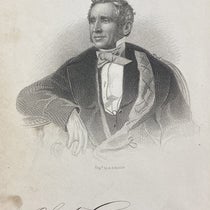Scientist of the Day - Eduard Suess
Eduard Suess, an Austrian geologist working in Vienna, was born Aug. 20, 1831. Suess is best known for coining the word "Gondwanaland" in 1861 for a proposed paleo-supercontinent consisting of Africa, South America, India, and Australia. But since continental drift was still fifty years in the future, that is what we call fame by hindsight, since Suess himself had no notion that continents might move about. Suess rather imagined that South American, Africa, India, and Australia were once connected, and that the intervening continental connections subsequently disappeared due to tectonic forces. I found no image explicitly depicting Suess’s Gondwanaland, but I did find a plate from a subsequent but unidentified publication that demonstrates Suess’s concept. Our modern reconstruction of Gondwana is quite different and looks like this.
A more important contribution by Suess was his suggestion that to do geology, you need to look at the big picture. In his magnum opus, Das Antlitz der Erde (The Face of the Earth, 1883-1909, 3 vols. in 5), he began by asking the reader to try to imagine the earth, not from the top of a mountain, but from space. If you do so, you will see certain patterns that need explaining – the way mountain chains in Europe have a long slow curve to the north, as if they have been pushed sideways from the south, while the mountains along the Pacific rim all face the Pacific Ocean, as if the ocean basin had a role in their formation. Suess believed that the prevailing theory – that mountains were pushed up from below – was insupportable; it rather appeared that huge transverse forces operated to push continental crust sideways, producing large-scale movements and immense folds. And the only way to account for such lateral forces was to conclude that the earth was slowly contracting, leaving the crust too big for its foundation, leading to subsidence and lateral compression. Suess's contracting earth hypothesis was the primary way geologists accounted for orogeny (mountain building) and tectonics (structure formation) until the idea of continental drift was proposed by Alfred Wegener in 1915, and for quite a few decades beyond that. Suess's version of global tectonics would ultimately give way to the plate tectonics revolution, but only in the 1960s. We have Suess’s Das Antlitz der Erde in our History of Science Collection. It contains a variety of maps, some colored; I thought the one of the Rocky Mountains would appeal to our mostly American readers (second image).
Trying to keep the ball rolling in our attempt to revive the clerihew (see our post on Edmund Clerihew Bentley and our recent discussion of Oliver Byrne), I have composed a humble offering with Suess as the subject, which again has been set to pastel by the supremely talented Melissa Dehner. We hope you enjoy it and groan just a little.

Eduard Suess, clerihew by the author, calligraphy and gouache drawing by Melissa Dehner (©Melissa Dehner)
Dr. William B. Ashworth, Jr., Consultant for the History of Science, Linda Hall Library and Associate Professor emeritus, Department of History, University of Missouri-Kansas City. Comments or corrections are welcome; please direct to ashworthw@umkc.edu.







